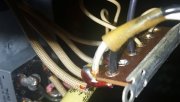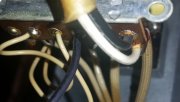Vintage 700b
Chief Journeyman
Hello Guys,
I disassembled my 700b down to the bare chassis, still need to replace the bridge rectifier, and fuse holders. When I disassembled, I noted wire routing and colors etc. At the terminal block, coming out of the transformer, I noted 120v on the left side, and 6 volts on the smaller right side.
I have always worked with Black wire =Hot, White wire = Neutral. I saw a black and a white wire going into this terminal block and cut the wires about 3” long, thinking it would be a simple hook up from line in to transformer later. I am aware of the thermal link, and power switch routing etc. from the fan plug, line in. Also have the correct routing for AC/DC from the bridge rectifier to the rest of the components.
I am posting some pictures of what I have however. I have a Black Wire AND a White wire going to the farthest left post, with an old piece of masking tape around them. Then the other leg into the transformer is also Black. As you can see the actual transformer wires have no colors. My question is which of these leads is Hot, and which is Neutral?
Thank You.



I disassembled my 700b down to the bare chassis, still need to replace the bridge rectifier, and fuse holders. When I disassembled, I noted wire routing and colors etc. At the terminal block, coming out of the transformer, I noted 120v on the left side, and 6 volts on the smaller right side.
I have always worked with Black wire =Hot, White wire = Neutral. I saw a black and a white wire going into this terminal block and cut the wires about 3” long, thinking it would be a simple hook up from line in to transformer later. I am aware of the thermal link, and power switch routing etc. from the fan plug, line in. Also have the correct routing for AC/DC from the bridge rectifier to the rest of the components.
I am posting some pictures of what I have however. I have a Black Wire AND a White wire going to the farthest left post, with an old piece of masking tape around them. Then the other leg into the transformer is also Black. As you can see the actual transformer wires have no colors. My question is which of these leads is Hot, and which is Neutral?
Thank You.



